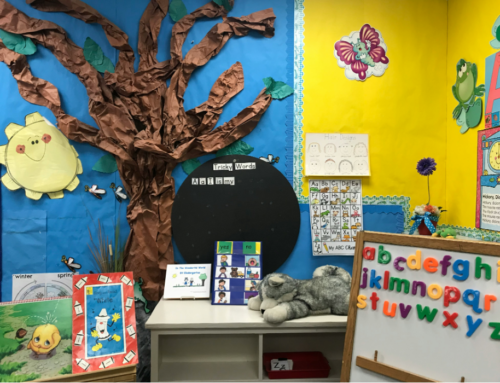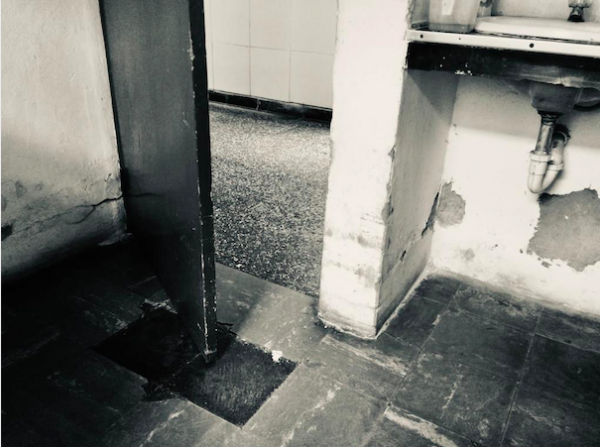
The cracked floors and peeled walls of a resident’s room.
Dilapidated furniture, peeled walls, cracked floors, cluttered up spaces. These are deteriorated landscapes, precarious topographies. How does a person—aged, poor, sick, and abandoned by family—grow old amidst precarity and institutionalization? The photographs in this collection are an attempt to show how the elderly urban poor of Lima, Peru, come to terms with the process of aging in such conditions. They are the graphic result of two years of ethnographic fieldwork conducted in a shelter for the abandoned elderly in one of the city’s most marginalized neighborhoods, El Rímac. While my research has primarily focused on the life trajectories and personal narratives of the elderly residents of this shelter—on people and their subjective worlds—these images center on the objects and spaces that envelop, inundate, and corrode their lives. The photos reveal the depth of abandonment that marks these older adults’ days as they come to terms with their old age and, finally, wait for death. The crumbling geographies in this collection are residents’ bedrooms within the institution. Precarity is condensed in the most intimate and personal spaces these men and women inhabit.

A wheelchair next to a wall permeated by humidity, resident’s room.
At this shelter—which I call “La Merced”—precarity weighs heavily on people’s everyday lives. As Anne Allison says in her lucid ethnography Precarious Japan, at La Merced, “precarity registers on the senses” (2013: 15). One can grasp it in the dense smell of an overcrowded bedroom, or when touching and looking at the dirty walls, damaged and permeated by humidity. And one confronts it in the idea of having to spend night after night in a bedroom where everything is lacking, except for the moon’s rays on the worn-out floor and the rickety bed that serves as an unsteady respite for sleep. The precarity of these spaces speaks of the uncertainty and rumbling instability—a “terrain muddied” in Allison’s words (2013: 13)—where those who lack family networks, care, and economic security must endlessly undertake new tactics of survival and resistance as they grow old.
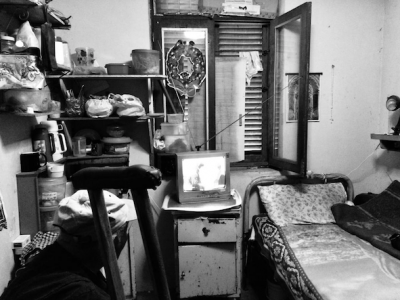
Cramped resident’s room.
The bedrooms, with their excesses and deprivations, with their absences and presences, speak of the precarious position these older adults occupy not only in the institution, but upon the socioeconomic landscape of the nation. Currently, there are more than 3.7 million people over the age of 60 living in Peru. This represents 12.4% of the population (INEI 2020), and that number continues to grow. For this reason, concern for the elderly is an emerging social issue. Nevertheless, to date, efforts to offer appropriate services to this group are enormously deficient. People in Peru are living longer (as in the rest of the world) but the conditions of living into old age are uncertain. La Merced seeks to provide care to those most in need by allocating basic material resources to people who are otherwise unable to secure them. The provision of care to older adults is often flawed, however, due to weak public policies, deficient funding, and institutional corruption.

Dilapidated furniture in a resident’s room.
The precarity that marks these decrepit bedrooms—with their shuttered windows, ramshackle beds, and broken-down furniture—is, precisely, a reflection of how macro-structural constraints shape the intimate life-worlds of the marginal elderly in a city like Lima. Pierced by uncertainty and suspended in time, the lives of their inhabitants hinge on doubt. Such doubt is the result of a material brokenness that tears subjective worlds apart and devastates inner affective lives. For many of my interlocutors, growing old in these rooms and under these circumstances means lacking the power of naming and claiming. Struggling for survival in spaces they commonly describe as “hopeless” and “demeaning,” they are reduced to what Giorgio Agamben (1998) has called “bare life”: life divested from social recognition, affection, dignity and even rights.
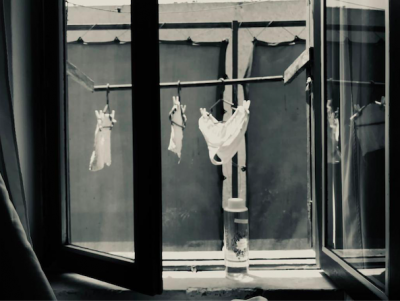
Window view from a resident’s room. Dry clothes are hanging from an improvised harness.
How is one to remain an autonomous, dignified actor at the end of life in an environment of perpetual loss, destitution, and abandonment? How do people render meaningful their experiences of aging? How do they bear living in such an inhospitable place? How do they survive? The shabby materialities portrayed in these images speak of the ways the elderly in Lima—and, probably, in many other parts of the Global South—grow old enveloped in absence and scarcity, adversity and vulnerability. They also reveal the relentless existential struggle for survival that these women and men must face. The photographs of these deeply precarious realities offer insight into how the elderly at this institution manage to weave with their actions a universe in which their ambition to endure life in the margins becomes visible. They speak of a human desire, which, to this day, I find hard to put into words. It is an unceasing desire, one that cannot be extinguished, a hope that can never be exhausted. The struggle of my interlocutors is a struggle for existence in a broken world. Their vitality calls for an existence surrounded by well-being, security, and affection. Beyond filthy walls, stuffed and barren spaces, and fissured floors, the light that enters through the windows of these bedrooms is radiant and penetrating; it can even surprise us with its iridescence. Precarity, yes. But also hope.
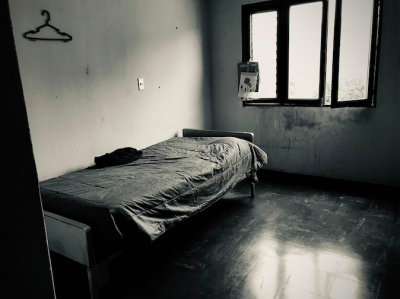
The rickety bed, dirty walls, and shuttered windows of a resident’s room.
References
Agamben, Giorgio. 1998. Homo Sacer: Sovereign Power and Bare Life. Stanford: Stanford University Press.
Allison, Anne. 2013. Precarious Japan. Durham: Duke University Press.
Instituto Nacional de Estadística e Informática (INEI). 2020. Situación de la población adulta mayor. Informe técnico. Octubre-Noviembre-Diciembre 2019. Lima.
Cite As: Zegarra Chiappori, Magdalena . 2022. Intimate Precarities: Growing Old in Lima, Peru, American Ethnologist website, 13 July 2022, [https://americanethnologist.org/features/reflections/intimate-precarities-growing-old-in-lima-peru]
Magdalena Zegarra Chiappori is a PhD candidate in Anthropology at The University of Michigan, Ann Arbor. Her work is located at the intersections of old age, care, and precarity.

